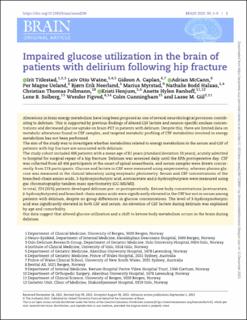| dc.contributor.author | Titlestad, Irit | |
| dc.contributor.author | Watne, Leiv | |
| dc.contributor.author | Caplan, Gideon A. | |
| dc.contributor.author | McCann, Adrian | |
| dc.contributor.author | Ueland, Per Magne | |
| dc.contributor.author | Neerland, Bjørn Erik | |
| dc.contributor.author | Myrstad, Marius | |
| dc.contributor.author | Halaas, Nathalie Bodd | |
| dc.contributor.author | Pollmann, Christian Thomas | |
| dc.contributor.author | Henjum, Kristi | |
| dc.contributor.author | Ranhoff, Anette Hylen | |
| dc.contributor.author | Solberg, Lene Bergendal | |
| dc.contributor.author | Figved, Wender | |
| dc.contributor.author | Cunningham, Colm | |
| dc.contributor.author | Melvær, Giil Lasse | |
| dc.date.accessioned | 2024-02-15T09:13:51Z | |
| dc.date.available | 2024-02-15T09:13:51Z | |
| dc.date.created | 2023-12-12T09:52:06Z | |
| dc.date.issued | 2024 | |
| dc.identifier.issn | 0006-8950 | |
| dc.identifier.uri | https://hdl.handle.net/11250/3117906 | |
| dc.description.abstract | Alterations in brain energy metabolism have long been proposed as one of several neurobiological processes contributing to delirium. This is supported by previous findings of altered CSF lactate and neuron-specific enolase concentrations and decreased glucose uptake on brain-PET in patients with delirium. Despite this, there are limited data on metabolic alterations found in CSF samples, and targeted metabolic profiling of CSF metabolites involved in energy metabolism has not been performed.
The aim of the study was to investigate whether metabolites related to energy metabolism in the serum and CSF of patients with hip fracture are associated with delirium.
The study cohort included 406 patients with a mean age of 81 years (standard deviation 10 years), acutely admitted to hospital for surgical repair of a hip fracture. Delirium was assessed daily until the fifth postoperative day. CSF was collected from all 406 participants at the onset of spinal anaesthesia, and serum samples were drawn concurrently from 213 participants. Glucose and lactate in CSF were measured using amperometry, whereas plasma glucose was measured in the clinical laboratory using enzymatic photometry. Serum and CSF concentrations of the branched-chain amino acids, 3-hydroxyisobutyric acid, acetoacetate and β-hydroxybutyrate were measured using gas chromatography-tandem mass spectrometry (GC-MS/MS).
In total, 224 (55%) patients developed delirium pre- or postoperatively. Ketone body concentrations (acetoacetate, β-hydroxybutyrate) and branched-chain amino acids were significantly elevated in the CSF but not in serum among patients with delirium, despite no group differences in glucose concentrations. The level of 3-hydroxyisobutyric acid was significantly elevated in both CSF and serum. An elevation of CSF lactate during delirium was explained by age and comorbidity.
Our data suggest that altered glucose utilization and a shift to ketone body metabolism occurs in the brain during delirium. | en_US |
| dc.language.iso | eng | en_US |
| dc.publisher | Oxford University Press | en_US |
| dc.rights | Navngivelse 4.0 Internasjonal | * |
| dc.rights.uri | http://creativecommons.org/licenses/by/4.0/deed.no | * |
| dc.title | Impaired glucose utilization in the brain of patients with delirium following hip fracture | en_US |
| dc.type | Journal article | en_US |
| dc.type | Peer reviewed | en_US |
| dc.description.version | publishedVersion | en_US |
| dc.rights.holder | Copyright 2023 The Author(s) | en_US |
| cristin.ispublished | true | |
| cristin.fulltext | original | |
| cristin.qualitycode | 2 | |
| dc.identifier.doi | 10.1093/brain/awad296 | |
| dc.identifier.cristin | 2212156 | |
| dc.source.journal | Brain | en_US |
| dc.source.pagenumber | 215-223 | en_US |
| dc.identifier.citation | Brain. 2024, 147 (1), 215-223. | en_US |
| dc.source.volume | 147 | en_US |
| dc.source.issue | 1 | en_US |

